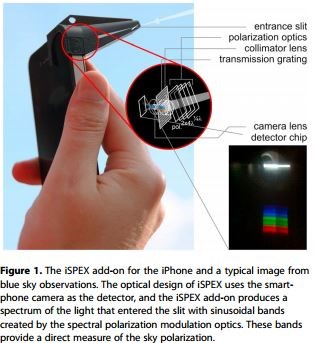 Scientists from University of Leiden in the Netherlands have created a low-cost, mass producible device that would allow everyday citizens to aid scientists in measuring atmospheric aerosols. Over the course of three days, 8,000 Dutch citizens lifted their smartphones to the sky. Using the iSPEX device attached to their smartphones, they were able to map aerosol properties with unprecedented spatiotemporal resolution. People using the device did not need any special training, just equipping them with the device allowed them to take part in a larger effort of data collection.
Scientists from University of Leiden in the Netherlands have created a low-cost, mass producible device that would allow everyday citizens to aid scientists in measuring atmospheric aerosols. Over the course of three days, 8,000 Dutch citizens lifted their smartphones to the sky. Using the iSPEX device attached to their smartphones, they were able to map aerosol properties with unprecedented spatiotemporal resolution. People using the device did not need any special training, just equipping them with the device allowed them to take part in a larger effort of data collection.
Atmospheric aerosols negatively affect our climate, destroy our stratospheric ozone, and even lower life expectancy in humans by exacerbating lung and cardiovascular diseases. Aerosols are tiny chemical particles suspended in our atmosphere. They are naturally produced from volcanic activity and dust from deserts. In addition, humans also contribute heavily to the amount of aerosols in the air through the use of coal, oil, and destruction of tropical forests. With all of the ways that atmospheric aerosols negatively affect humans, it is important to monitor the changing levels of aerosols in the air. However, up until now that information has been difficult to obtain and the data that is collected provides only limited information on particle characteristics. Understanding airborne aerosols is a major issue for programs aimed at improving air quality.
This technology is still in preliminary stages, but it is an important step in what could be the future of airborne data collection. This type of system will likely present numerous other practical uses for data collection, and it will be interesting to see where this technology goes in the future.
Sara Dunlap
GIS analyst
sdunlap@banksinfo.com
